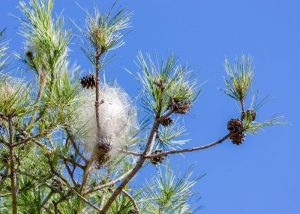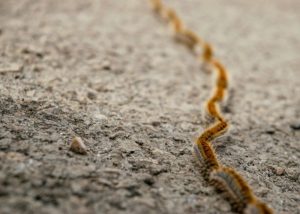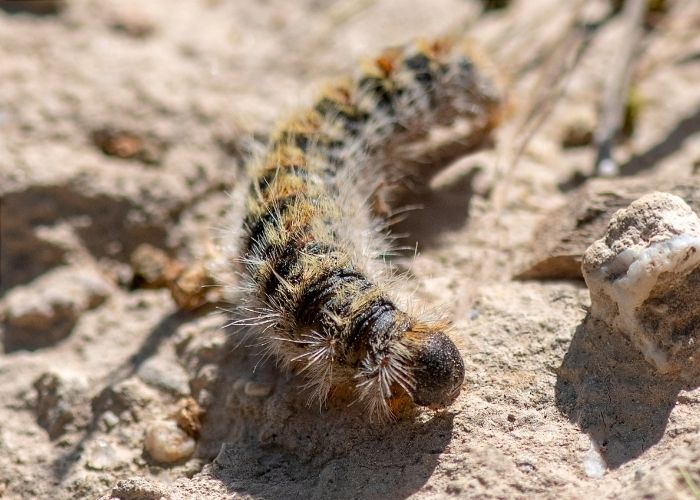UPDATE – If you are going for a walk in the campo, keep your dog on the lead, and beware of the pine processionary caterpillars! The forestry police in La Pedriza, Madrid saw a trail of 1600 metres. It is now January, and in many parts of Spain, the weather is still very warm. However, this could also mean some early unwanted visitors – Pine processionary caterpillars!
Pine Processionary Caterpillars (Thaumetopoea Pityocmapa) can be dangerous to humans and nature, but also potentially deadly to our four-legged friends.
Why are they called processionary caterpillars?
These creatures are known as processionary as they make a long line and follow each other nose to tail. Although each caterpillar is only around 3-4cm in length, these chains can sometimes contain hundreds of them. They are usually an orange/brown colour and are covered in small poisonous harpoon-like spines that look like hairs. These continue to remain toxic, even if the caterpillar is dead.
 Pine tree cocoons
Pine tree cocoons
The caterpillars can be found building their cocoons high in the pine trees. The cocoons look like big white balls of candy floss; however, they will contain hundreds of caterpillars in each one.
When the larvae are ready to pupate between late winter, early spring, they will march single file down the tree to the ground where they disperse looking for somewhere to continue their life cycle. However, due to changes in weather, such as a warmer winter, the caterpillars can sometimes emerge earlier than expected.
Unfortunately, you don’t have to visit a forest to meet them. Many parks and communal areas in Spain feature pine trees. So, you can just as easily find them in urban areas. Also, they may travel some distance from their original tree in search of a new place.
What to Do if You Find a Nest
If you find a nest do not touch it! Contact the ayuntamiento or garden specialists immediately. If you have pine trees in your garden, the best option is to have them treated to prevent the caterpillars from making the cocoons.
Do not attempt to get rid of the nests by yourself. Even if the nest is empty, the hairs from the caterpillars may still be present so still pose a danger to health. There are many suggestions on social media as to how to “do it yourself” by using hairspray or burning the nests. If the nests are not removed by a professional the hairs may become airborne causing further issues.
The dangers
The dangers of the processionary caterpillar cannot be understated. For children and adults, breathing difficulties or allergic reactions are common.
Children and adults
The hairs contain an urticating protein called Thaumetopoein which can in minor cases cause skin irritation or a rash much like that experienced after rubbing a stinging nettle. Although, in most cases, an antihistamine cream will usually be enough to alleviate the symptoms.
However, in more severe cases, humans can experience allergic reactions or respiratory problems. Asthmatics are particularly vulnerable and at risk of having a severe attack.
Dogs and cats
Many owners have lost their pets when out walking if they come across the caterpillars. Dogs and cats may be curious, but if they inhale any of the hairs, they could suffer severe swelling and therefore must be taken immediately to a vet if they are to have any chance of survival. For those that survive, often they must have their tongue amputated.
When walking your dog in wooded areas, it is best to always keep them on a lead to ensure they don’t come into contact with them. Although they form a long line, they are often hard to spot until the last minute.
Even loose hairs that may be on the ground are also highly toxic as they will get caught in a dog’s paw. The dog will then attempt to clean them which transfers the hairs to its tongue resulting in vomiting, swelling of the tongue, and potentially suffocation.
If possible, avoid walking your dogs in wooded areas, especially during Spring.
What to do if you come into contact with them
 In schools in Spain, as a precautionary measure, if any child has been in contact with these caterpillars, they are taken to the hospital to be checked.
In schools in Spain, as a precautionary measure, if any child has been in contact with these caterpillars, they are taken to the hospital to be checked.
If your pet meets processionary caterpillars, they may have small white spots around their mouth or on their tongue. A rash may develop which will lead to drooling and distress. The tongue may also start to swell which could be followed by vomiting and potential suffocation. Therefore, it is important to immediately wear gloves and wash the animal´s mouth with warm water and go as fast as possible to your nearest vet.
More information on pine processionary caterpillars.


